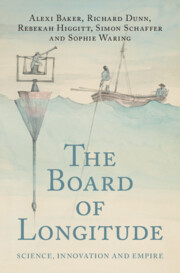Book contents
- The Board of Longitude
- The Board of Longitude
- Copyright page
- Dedication
- Contents
- Figures
- Tables
- Boxes
- Acknowledgements
- Timeline
- Abbreviations
- 1 Introduction
- 2 Sailing the Oceans and Seeking Longitude before 1714
- 3 Launching the Eighteenth-Century Search for Longitude
- 4 The Early Commissioners in Transition
- 5 The Birth of the Board of Longitude
- 6 Time Trials
- 7 Manufacturing the Nautical Almanac
- 8 Managing, Communicating and Judging Longitude after Harrison, 1774–c. 1800
- 9 A Practical Institution Weighed Down by Impractical Proposals?
- 10 What Is an Observatory? From the Metropolis to the Cape
- 11 The Death and Rebirth of the Board of Longitude
- Epilogue
- Book part
- Glossary
- Bibliography
- Index
8 - Managing, Communicating and Judging Longitude after Harrison, 1774–c. 1800
Published online by Cambridge University Press: 11 April 2025
- The Board of Longitude
- The Board of Longitude
- Copyright page
- Dedication
- Contents
- Figures
- Tables
- Boxes
- Acknowledgements
- Timeline
- Abbreviations
- 1 Introduction
- 2 Sailing the Oceans and Seeking Longitude before 1714
- 3 Launching the Eighteenth-Century Search for Longitude
- 4 The Early Commissioners in Transition
- 5 The Birth of the Board of Longitude
- 6 Time Trials
- 7 Manufacturing the Nautical Almanac
- 8 Managing, Communicating and Judging Longitude after Harrison, 1774–c. 1800
- 9 A Practical Institution Weighed Down by Impractical Proposals?
- 10 What Is an Observatory? From the Metropolis to the Cape
- 11 The Death and Rebirth of the Board of Longitude
- Epilogue
- Book part
- Glossary
- Bibliography
- Index
Summary
This chapter surveys the workings of the British Board of Longitude in the period from the mid-1770s, which saw expenditure and bureaucracy increase. The Longitude Act of 1774 cut rewards and tightened the criteria for success. Managed through a permanent secretary, the Board more resembled an office of state, while personal and patronage relations still played vital roles in its conduct. Both Astronomer Royal Nevil Maskelyne and Joseph Banks exploited the Board to further their own interests in policy and organisation in projects including management of the Nautical Almanac and its computers, supply of instruments to survey voyages, and trials of new kinds of optical glass. The chapter explains how Maskelyne used the Board to extend networks centred on the Royal Observatory, Greenwich, while Banks used his position as a Commissioner of Longitude to mend relations with the Admiralty and extend patronage. Although there were major tensions and conflicts with Maskelyne, Banks was able effectively to make the Board of Longitude an integral component of his system of public administration over the sciences.
- Type
- Chapter
- Information
- The Board of LongitudeScience, Innovation and Empire, pp. 192 - 209Publisher: Cambridge University PressPrint publication year: 2025

